After many years I am still a beginner, not a master gardener, nor a landscape architect, nor any other qualified expert. I simply love plants—all plants, from the Redwoods in the California fog to the moss in the cracks of my stoop. That makes for a big garden! I like to watch plants. They are such super-slow motion creatures. That gives us time. These pages are some of my watchings.
Nikolas Majchrzak
.
FLOWERING DOGWOOD
Cornus florida
There is In the small town of Berea, Kentucky, a famous college. It’s a liberal arts college founded in 1855 and is simply called Berea College. It is distinctive in several ways. It not only provided free education to all its students, it was the first college in the southern United States to be both co-educational and racially integrated. And that was before the Civil War.
Berea College was founded by John Gregg Fee, a Christian pastor and abolitionist. He found a way to educate the poor students of Appalachia without charging tuition. Each student was required to work for the college, sharing the skills they learned at home. A furniture shop was opened, along with other trades, like blacksmithing, weaving, and broom-making. The products were sold to help fund the school.
Berea College still offers a no-tuition education. All students are given a full four-year scholarship and are required to participate in some form of work-study. Today Berea College is ranked number one among liberal arts colleges in the U.S.
The high quality furniture made at Berea College is both famous and sought after. The college’s salesroom offers a variety of practical and unique products.
John Fee chose the name Berea for both the town and the college from the city in Greece mentioned in the Bible book of Acts where “the people of Berea were more noble than those in Thessalonica, in that they received the word with all readiness of mind, and searched the scriptures daily, whether those things were so.” How apt. And what good fruition.
The craftsmanship of Berea College spawned an arts and crafts culture in the town of Berea.
The artisan community now includes a thriving population of weavers, instrument makers, furniture artisans, jewelry designers, glass workers, potters, painters, sculptors, and musicians.
There are several Arts and Crafts Festivals throughout the summer. It’s a wonderful place to visit.
The last time my wife and I were there we found in one of the shops a wood carved Aster. It was a three dimensional carving. It looked like an actual flower. You could pick it up and hold it in your hand. The carver had made overlapping slicing cuts to form the flower petals. It was fascinating. There was also another carved flower, but it was a bit strange. It had only four petals, but they were crooked and bent, and for some reason the carver had burned holes at the end of each petal leaving a scorch mark around it. We bought the Aster.
Years later I realized that the other “strange” flower was a perfect replica of a Dogwood flower. Being from Wisconsin I had never seen one. We thought Dogwoods were shrubs with red twigs, the Osier Dogwood, a pretty plant in its own right, especially in the snow.
Flowering Dogwood trees are native everywhere east of the Mississippi River except for parts of Illinois and all of Wisconsin. A few states on the western side of the Mississippi in the south also have them.
An old story says that the Flowering Dogwood was the tree used for Jesus’ crucifixion. Ever since, the flowers are cruciform. The four ends of the cross have nail holes indicating the wounds of Christ, and do notice, the nail holes have blood stains around them.
As the bloom season comes to an end the yellow clump of florets in the center of the cross becomes a spiky “crown of thorns.”
There is also a pink variation of the Dogwood flower.
Like the Poinsettia the Dogwood’s flower petals are not really petals at all, but bracts–specialized colored leaves. The real flowers are actually the cluster of little, knobby florets in the center of the large bracts.
Unlike many flowering trees in spring that bloom only for a brief time, often wilting soon after the tree reaches full blossoming, the Flowering Dogwood’s blooms last for several weeks. That makes it a bit more predictable for planning “Dogwood Festivals,” as in the southern city of Atlanta.
The tree itself is not large, reaching only 30 feet in height. Because the branches grow horizontally, the tree often is wider than it is tall. As the flowers and leaves add weight to the growing twigs, the tips tend to droop giving the tree an umbrella shape. We have such an umbrella shading a corner of our deck. We love it.
In the wild Dogwoods are most often seen at the edge of the woods. In spring you will see an umbrella arc of white flowers sticking out of the woodlands along highways.
In open sunlight the Flowering Dogwood makes an impressive specimen tree.
In fall Dogwood leaves turn red to maroon. Unlike most trees of the north that lose their leaves as soon as the color climaxes, Flowering Dogwood keeps its colored leaves for months. A gracious close to summer, indeed.
Dogwoods are easy to identify. Their large white flowers in spring are characteristic. Their small size and arching umbrella shape are easy to spot. And their bark is like nothing else. It is a “dragon skin,” with many small scale-like separations..
Flowring Dogwood is an altogether lovely tree that brings three seasons of joy. If you want winter joy, too, get a Red-twig Dogwood as well.
If you happen to go to Berea in spring you will no doubt see Dogwood flowers. If you see carved wooden ones, set one aside for me.
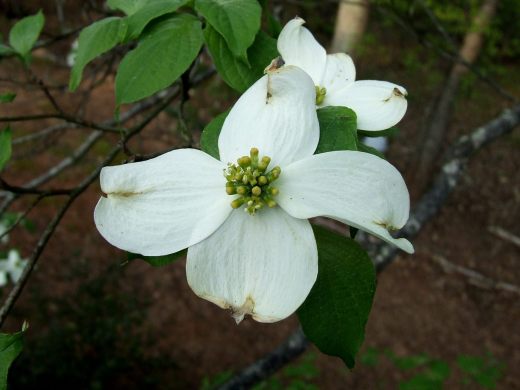

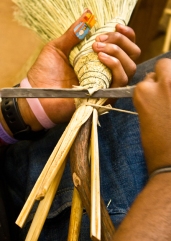
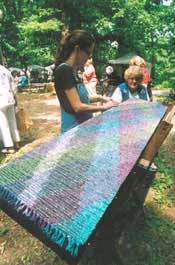
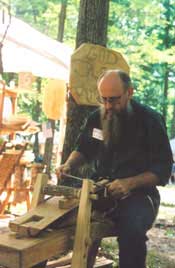
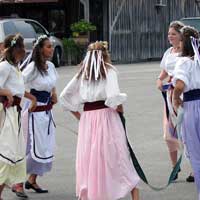
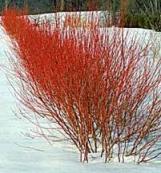
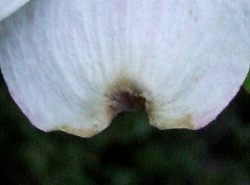
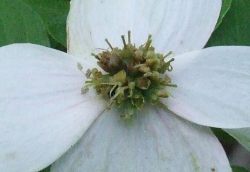
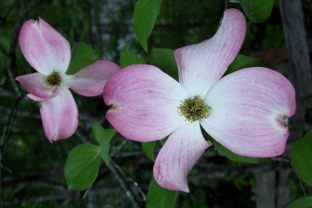
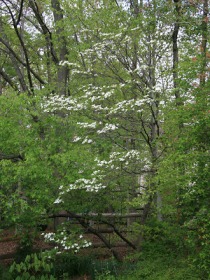
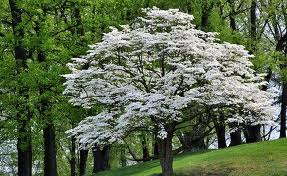
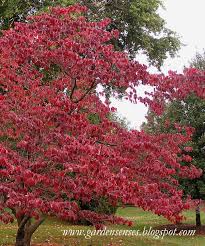
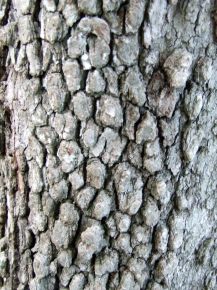
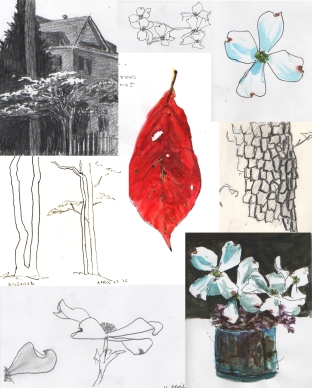
I like the pictures.